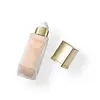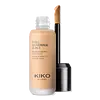KIKO Milano Holiday Première 24h Lasting Foundation Versus KIKO Milano Full Coverage 2-In-1 Foundation & Concealer
What's inside
What's inside
 Key Ingredients
Key Ingredients

 Benefits
Benefits

 Concerns
Concerns

 Ingredients Side-by-side
Ingredients Side-by-side

Water
Skin ConditioningDimethicone
EmollientPolymethyl Methacrylate
Polymethylsilsesquioxane
Methyl Trimethicone
Skin ConditioningPEG-10 Dimethicone
Skin ConditioningGlycerin
HumectantButylene Glycol
HumectantAcrylates/Dimethicone Copolymer
Skin ConditioningSodium Potassium Aluminum Silicate
PEG/PPG-18/18 Dimethicone
EmulsifyingSodium Chloride
MaskingTrimethylsiloxysilicate
EmollientCaprylyl Dimethicone Ethoxy Glucoside
EmulsifyingDisteardimonium Hectorite
StabilisingTriethyl Citrate
MaskingDimethicone Crosspolymer
Emulsion StabilisingSilica
AbrasiveTriethoxycaprylylsilane
Aluminum Hydroxide
EmollientTocopheryl Acetate
AntioxidantDisodium EDTA
Bacillus/Soybean Ferment Extract
Skin ConditioningPotassium Sorbate
PreservativeSodium Dehydroacetate
PreservativePhenoxyethanol
PreservativeAroma
Limonene
PerfumingCinnamal
PerfumingCI 77491
Cosmetic ColorantCI 77499
Cosmetic ColorantCI 77891
Cosmetic ColorantWater, Dimethicone, Polymethyl Methacrylate, Polymethylsilsesquioxane, Methyl Trimethicone, PEG-10 Dimethicone, Glycerin, Butylene Glycol, Acrylates/Dimethicone Copolymer, Sodium Potassium Aluminum Silicate, PEG/PPG-18/18 Dimethicone, Sodium Chloride, Trimethylsiloxysilicate, Caprylyl Dimethicone Ethoxy Glucoside, Disteardimonium Hectorite, Triethyl Citrate, Dimethicone Crosspolymer, Silica, Triethoxycaprylylsilane, Aluminum Hydroxide, Tocopheryl Acetate, Disodium EDTA, Bacillus/Soybean Ferment Extract, Potassium Sorbate, Sodium Dehydroacetate, Phenoxyethanol, Aroma, Limonene, Cinnamal, CI 77491, CI 77499, CI 77891
Water
Skin ConditioningDimethicone
EmollientIsohexadecane
EmollientIsononyl Isononanoate
EmollientCaprylyl Dimethicone Ethoxy Glucoside
EmulsifyingDimethicone Crosspolymer
Emulsion StabilisingZinc Stearate
Cosmetic ColorantSorbitan Isostearate
EmulsifyingSqualane
EmollientGlycerin
HumectantButylene Glycol
HumectantAluminum/Magnesium Hydroxide Stearate
Emulsion StabilisingMica
Cosmetic ColorantPhenoxyethanol
PreservativeSodium Chloride
MaskingHexylene Glycol
EmulsifyingPotassium Sorbate
PreservativeSodium Dehydroacetate
PreservativeMaltodextrin
AbsorbentTocopheryl Acetate
AntioxidantFructose
HumectantGlucose
HumectantVoandzeia Subterranea Seed Extract
Skin ConditioningDextrin
AbsorbentSucrose
HumectantUrea
BufferingAlanine
MaskingAspartic Acid
MaskingGlutamic Acid
HumectantHydrolyzed Vegetable Protein
Skin ConditioningCI 77891
Cosmetic ColorantCI 77491
Cosmetic ColorantWater, Dimethicone, Isohexadecane, Isononyl Isononanoate, Caprylyl Dimethicone Ethoxy Glucoside, Dimethicone Crosspolymer, Zinc Stearate, Sorbitan Isostearate, Squalane, Glycerin, Butylene Glycol, Aluminum/Magnesium Hydroxide Stearate, Mica, Phenoxyethanol, Sodium Chloride, Hexylene Glycol, Potassium Sorbate, Sodium Dehydroacetate, Maltodextrin, Tocopheryl Acetate, Fructose, Glucose, Voandzeia Subterranea Seed Extract, Dextrin, Sucrose, Urea, Alanine, Aspartic Acid, Glutamic Acid, Hydrolyzed Vegetable Protein, CI 77891, CI 77491
 Reviews
Reviews

Ingredients Explained
These ingredients are found in both products.
Ingredients higher up in an ingredient list are typically present in a larger amount.
Butylene Glycol (or BG) is used within cosmetic products for a few different reasons:
Overall, Butylene Glycol is a safe and well-rounded ingredient that works well with other ingredients.
Though this ingredient works well with most skin types, some people with sensitive skin may experience a reaction such as allergic rashes, closed comedones, or itchiness.
Learn more about Butylene GlycolCaprylyl Dimethicone Ethoxy Glucoside is a type of silicone.
Ci 77491 is also hydrated iron III oxide. It's sole purpose is to give a red/pink hue to products.
Iron III oxides are classified as inorganic chemicals for coloring.
Synthetically created Ci 77491 is considered safer than those naturally found. This is because the synthetically created version may contain less impurities. Iron oxides are generally non-toxic and non-allergenic.
Learn more about CI 77491Ci 77891 is a white pigment from Titanium dioxide. It is naturally found in minerals such as rutile and ilmenite.
It's main function is to add a white color to cosmetics. It can also be mixed with other colors to create different shades.
Ci 77891 is commonly found in sunscreens due to its ability to block UV rays.
Learn more about CI 77891Dimethicone is a type of synthetic silicone created from natural materials such as quartz.
What it does:
Dimethicone comes in different viscosities:
Depending on the viscosity, dimethicone has different properties.
Ingredients lists don't always show which type is used, so we recommend reaching out to the brand if you have questions about the viscosity.
This ingredient is unlikely to cause irritation because it does not get absorbed into skin. However, people with silicone allergies should be careful about using this ingredient.
Note: Dimethicone may contribute to pilling. This is because it is not oil or water soluble, so pilling may occur when layered with products. When mixed with heavy oils in a formula, the outcome is also quite greasy.
Learn more about DimethiconeDimethicone Crosspolymer is a silicone created by modifying dimethicone with hydrocarbon side chains. Due to its large size, it does not penetrate skin. It is considered non-occlusive.
Dimethicone Crosspolymer is used to stabilize and thicken products. It also helps give products a silky feel.
Glycerin is already naturally found in your skin. It helps moisturize and protect your skin.
A study from 2016 found glycerin to be more effective as a humectant than AHAs and hyaluronic acid.
As a humectant, it helps the skin stay hydrated by pulling moisture to your skin. The low molecular weight of glycerin allows it to pull moisture into the deeper layers of your skin.
Hydrated skin improves your skin barrier; Your skin barrier helps protect against irritants and bacteria.
Glycerin has also been found to have antimicrobial and antiviral properties. Due to these properties, glycerin is often used in wound and burn treatments.
In cosmetics, glycerin is usually derived from plants such as soybean or palm. However, it can also be sourced from animals, such as tallow or animal fat.
This ingredient is organic, colorless, odorless, and non-toxic.
Glycerin is the name for this ingredient in American English. British English uses Glycerol/Glycerine.
Learn more about GlycerinPhenoxyethanol is a preservative that has germicide, antimicrobial, and aromatic properties. Studies show that phenoxyethanol can prevent microbial growth. By itself, it has a scent that is similar to that of a rose.
It's often used in formulations along with Caprylyl Glycol to preserve the shelf life of products.
Potassium Sorbate is a preservative used to prevent yeast and mold in products. It is commonly found in both cosmetic and food products.
This ingredient comes from potassium salt derived from sorbic acid. Sorbic acid is a natural antibiotic and effective against fungus.
Both potassium sorbate and sorbic acid can be found in baked goods, cheeses, dried meats, dried fruit, ice cream, pickles, wine, yogurt, and more.
You'll often find this ingredient used with other preservatives.
Learn more about Potassium SorbateChances are, you eat sodium chloride every day. Sodium Chloride is also known as table salt.
This ingredient has many purposes in skincare: thickener, emulsifier, and exfoliator.
You'll most likely find this ingredient in cleansers where it is used to create a gel-like texture. As an emulsifier, it also prevents ingredients from separating.
There is much debate on whether this ingredient is comedogenic. The short answer - comedogenic ratings don't tell the whole story. Learn more about comegodenic ratings here.
The concensus about this ingredient causing acne seems to be divided. Research is needed to understand if this ingredient does cause acne.
Scrubs may use salt as the primary exfoliating ingredient.
Learn more about Sodium ChlorideThis ingredient is a preservative with antimicrobial properties. It is the sodium salt of dehydroacetic acid.
It is especially effective at preventing bacterial and fungal growth in low concentrations.
Tocopheryl Acetate is AKA Vitamin E. It is an antioxidant and protects your skin from free radicals. Free radicals damage the skin by breaking down collagen.
One study found using Tocopheryl Acetate with Vitamin C decreased the number of sunburned cells.
Tocopheryl Acetate is commonly found in both skincare and dietary supplements.
Learn more about Tocopheryl AcetateWater. It's the most common cosmetic ingredient of all. You'll usually see it at the top of ingredient lists, meaning that it makes up the largest part of the product.
So why is it so popular? Water most often acts as a solvent - this means that it helps dissolve other ingredients into the formulation.
You'll also recognize water as that liquid we all need to stay alive. If you see this, drink a glass of water. Stay hydrated!
Learn more about Water